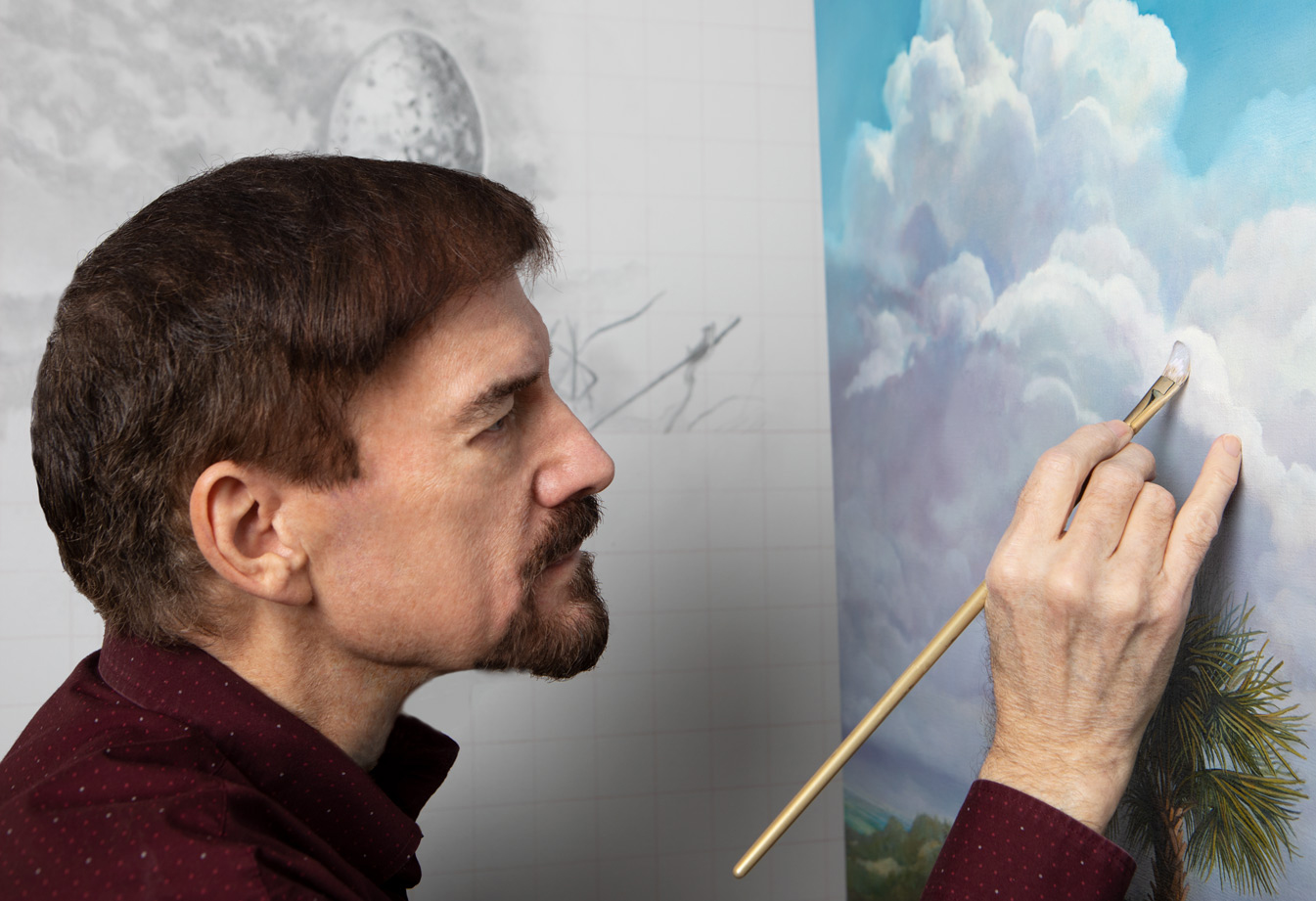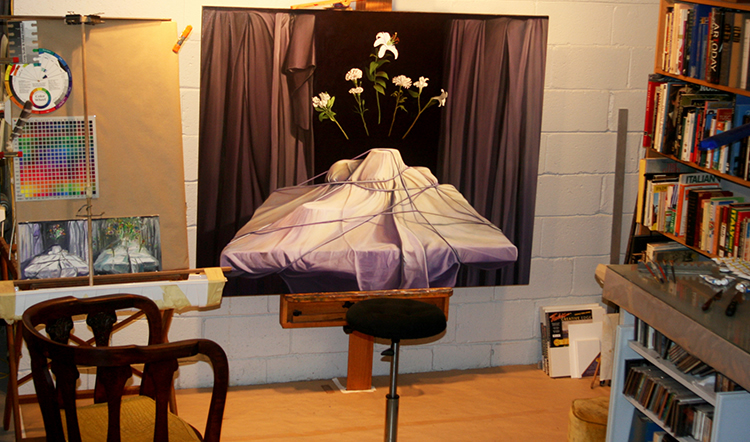Art is a coherent multi-dimensional energy that is the synthesis of the heart, the mind and intuition. The artist is the conduit of the flow of that creative energy.

About the Artist
Michael Gaston spent his formative years in Japan and later studied in Italy, Philadelphia and New York, all of which proved to have a profound influence on his career as an artist. His paintings, pastels, prints and drawings have been shown in various museums, galleries and exhibitions in the United States and abroad. They are also part of many corporate and private collections.
His works on canvas and paper are known for their use of vivid light and rich color that combine with an original and personal vision.
As a figurative painter he strives for a more contemporary use of bold design and simple composition. As a landscape and still life painter he prefers a more mystical and lyrical approach. He currently works and resides in the Atlanta, Georgia area.
Exhibitions
- Chastain Arts Center Invitational, Atlanta, GA
- Art Station Gallery, Stone Mountain, GA
- Atlanta Art Gallery, Atlanta, GA
- 11th International Southeastern Pastel Society, Marietta Cobb Museum of Art, Marietta, GA
- Faculty Exhibit, Art Institute of Atlanta,
Atlanta, GA - Chastain Arts Center, Atlanta, GA
- Right Brain Gallery, Atlanta, GA
- Royal Caribbean Cruise Lines, Oslo, Norway
- Ninth Annual Southern Juried Fine Arts Show, Douglasville, GA
- Recent Finds, L5P Community Center,
Atlanta, GA - Euclid Artists, L5P Community Center,
Atlanta, GA - Solo Exhibition, Graffiti Gallery, Atlanta, GA
- Passport to France, Atlanta, GA
- Solo Exhibition, Callanwolde Fine Arts Center, Atlanta, GA
- Solo Exhibition, Georgia Institute of Technology, Atlanta, GA
- Stine Group Exhibition, H.L. Stine Fine Arts, Atlanta, GA
- Artists in Preparation, New Visions Gallery, Atlanta, GA
- Art, Science and the Imagination Invitational Arts Festival, Atlanta, GA
- Solo Exhibition, H.L. Stine Fine Arts,
Atlanta, GA - Gallery Artists Exhibit, Bell-Ross Gallery, Memphis, TN
- Selections from Atlanta Galleries, Atlanta City Club, Atlanta, GA
- Solo Exhibition, H.L. Stine Fine Arts,
Atlanta, GA - Competition Art Services Gallery, Atlanta, GA
- Art Haven Group Exhibit, Atlanta, GA
- Art Haven Group Exhibition, Atlanta, GA
- Portfolio Gallery, Atlanta, GA
- Portfolio Gallery, Atlanta, GA
- Portfolio Gallery, Atlanta, GA
- Nexus Group Exhibition, Nexus Contemporary Arts Center, Atlanta, GA
- Atlanta Artists, Fay Gold Gallery, Atlanta, GA
- Portfolio Gallery, Atlanta, GA
- Nexus Artists, Nexus Contemporary Arts Center, Atlanta, GA
- Northeastern Pennsylvania Invitational, Traveling Exhibition
- Everhardt Museum, Scranton, PA
- Lehigh University, Bethlehem, PA
- Miseriacordia College, Dallas, PA
- Hazelton Arts League, Hazelton, PA
(Exhibitions Continued)
- Allentown Museum Annual,
Allentown Art Museum, Allentown, PA - Lehigh Print Invitational,
Lehigh University, Bethlehem, PA - Moravian Faculty Exhibit,
Moravian College, Bethlehem, PA - Cheltenham Annual, Cheltenham, PA
- Wisconsin Exchange Exhibition,
University of Wisconsin, Madison, WI - Philadelphia Print Club Annual, Philadelphia, PA
- Solo Exhibition, Tyler School of Art,
Temple University, Philadelphia, PA - Olean Art Annual, Olean, NY
- Solo Exhibition, East Carolina
University, Greenville, NC - Traveling Print Exhibition, East
Carolina University, Greenville, NC
Education
Tyler School of Art, Temple University, Philadelphia, PA, M.F.A. Degree.
Tyler School of Art, Temple University Abroad,
Rome, Italy.
East Carolina University, Greenville, NC, B.F.A. Degree
Teaching
Emory University
Bauder College
Art Institute of Atlanta
Atlanta College of Art
Clark Atlanta University
Moravian College
Temple University,
Tyler School of Art
Collections
Royal Caribbean Cruise Lines
Flight International, Inc.
Dean Witter, Inc.
Temple University
East Carolina University
Commissions
Royal Caribbean Cruise Lines, Oslo, Norway

The central purpose in my latest body of work is to conceive and then apply a transformative and individual vision – to show an improbable reality.
Working in the studio includes making drawings and paintings that reflect my own struggle with art issues and by resolving visual problems that face artists like myself every day. For example, I employ multiple painting techniques that include tonal underpainting, scumbling, transparent glazes and impastos that I have perfected over time.
When mixing color, I create a limited palette of split complementary colors that have served me well. I incorporate the use of dynamic symmetry, (the golden ratio and root rectangles) to structure the underlying composition of drawings and paintings.
Form and content must always work together in my art; therefore, a sound underlying abstract structure is an important consideration in all that I do. This reconciliation of abstraction and realism in my paintings allows me to explore new models and motifs.
The artist Odilon Redon expresses a point very clearly for me: "While I recognize the necessity for a basis of observed reality – true art lies in a reality that is felt." I attempt to balance both the psychological and compositional aspects of my art.
